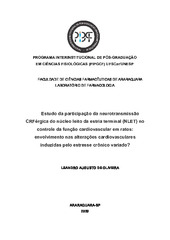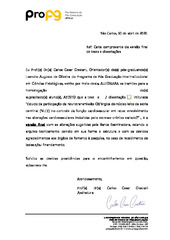| dc.contributor.author | Oliveira, Leandro Augusto de | |
| dc.date.accessioned | 2020-05-22T11:54:26Z | |
| dc.date.available | 2020-05-22T11:54:26Z | |
| dc.date.issued | 2020-03-06 | |
| dc.identifier.citation | OLIVEIRA, Leandro Augusto de. Estudo da participação da neurotransmissão CRFérgica do núcleo leito da estria terminal (NLET) no controle da função cardiovascular em ratos: envolvimento nas alterações cardiovasculares induzidas pelo estresse crônico variado?. 2020. Tese (Doutorado em Ciências Fisiológicas) – Universidade Federal de São Carlos, São Carlos, 2020. Disponível em: https://repositorio.ufscar.br/handle/ufscar/12756. | * |
| dc.identifier.uri | https://repositorio.ufscar.br/handle/ufscar/12756 | |
| dc.description.abstract | The aim of the present study was to investigate the role of CRFergic neurotransmission into bed nucleus of stria terminalis (BNST) on cardiovascular function. We observed that bilateral microinjection of the selective CRF1 antagonist CP376395 into BNST reduced the reflex bradycardia without affecting the tachycardia. Conversely the BNST treatment with antisauvagine-30 decreased heart rate response during medial arterial pressure drop without affecting the reflex bradycardia. These findings provide evidence of an involvement of CRF neurotransmission within BNST in baroreflex activity. Secondly, we assessed the interaction of CRF neurotransmission within BNST with local nitrergic signaling, as well as to investigate an involvement of activation of local NMDA glutamate receptor and nitric oxide (NO) signaling in control of cardiovascular responses to acute restraint stress by BNST CRF neurotransmission in rats. We observed that CRF microinjection into the BNST increased local NO release during restraint stress. Furthermore, bilateral microinjection of CRF into the BNST enhanced both the arterial pressure and heart rate increases evoked by restraint stress, but without affecting the sympathetically-mediated cutaneous vasoconstriction. The facilitation of both pressure and tachycardiac responses to restraint stress evoked by BNST treatment with CRF were completely inhibited by local pretreatment with either the selective NMDA glutamate receptor antagonist LY235959, the selective neuronal nitric oxide synthase (nNOS) inhibitor NPLA, the soluble guanylate cyclase (sGC) inhibitor ODQ or the protein kinase G (PKG) inhibitor KT5923. Taken together, these results provide evidence that BNST CRF neurotransmission facilitate local NMDA-mediated glutamatergic neurotransmission and activates nitrergic signaling, and this pathway is local NMDA-mediated glutamatergic neurotransmission and activates nitrergic signaling, which pathway is involved in control of cardiovascular responses to stress. We investigated the involvement of BNST CRFergic neurotransmission in cardiovascular changes evoked by chronic stress in rats. We identified that exposure to a 10-day chronic variable stress (CVS) protocol decreased expression of both CRF1 and CRF2 receptors within the BNST. These effects were followed by increased arterial pressure and impairment of baroreflex function, but without changes on heart rate. Bilateral microinjection of CP376395, or antisauvagine-30 into the BNST did not affect CVS-evoked arterial pressure increase. Nevertheless, BNST treatment with CP376395 decreased both tachycardiac and bradycardiac responses of the baroreflex in non-stressed rats; but these effects were not identified in chronically stressed animals. BNST pharmacological treatment with antisauvagine-30 decreased the reflex tachycardia in control animals, whereas reflex bradycardiac response was increased in CVS animals. Therefore, the results reported in the present study indicate an involvement of both CRF1 and CRF2 receptors within the BNST in baroreflex impairment evoked by chronic stress. Furthermore, the exposition of rats into the CVS protocol did not change the sucrose preference. However, the pharmacological treatment into BNST with CRF1 antagonist reduced the sucrose preference only in control group. The molecular data resulted in no alteration of the number of CRF neurons into BNST. Last, but not least, when the role of CRF1 receptors into BNST were evaluated during the social model of witness stress, the microinjection of CP376395 into BNST reduced the pressor responses on day 5, without changing others parameters. Altogether, the results of this present thesis show the participation of BNST CRF neurotransmission in the control of cardiovascular function in resting conditions and during acute and chronic aversive situations. | eng |
| dc.description.sponsorship | Fundação de Amparo à Pesquisa do Estado de São Paulo (FAPESP) | por |
| dc.language.iso | por | por |
| dc.publisher | Universidade Federal de São Carlos | por |
| dc.rights | Attribution-NonCommercial-NoDerivs 3.0 Brazil | * |
| dc.rights.uri | http://creativecommons.org/licenses/by-nc-nd/3.0/br/ | * |
| dc.subject | Núcleo leito da estria terminal | por |
| dc.subject | Fator liberador de corticotrofina | por |
| dc.subject | Barorreflexo | por |
| dc.subject | Estresse | por |
| dc.subject | Bed nucleus of stria terminalis | eng |
| dc.subject | Corticotropin releasing factor | eng |
| dc.subject | Baroreflex | eng |
| dc.subject | Stress | eng |
| dc.title | Estudo da participação da neurotransmissão CRFérgica do núcleo leito da estria terminal (NLET) no controle da função cardiovascular em ratos: envolvimento nas alterações cardiovasculares induzidas pelo estresse crônico variado? | por |
| dc.title.alternative | Role of CRF neurotransmission in the bed nucleus of the stria terminalis in control of cardiovascular function in rats: involvement in cardiovascular changes evoked by chronic variable stress? | eng |
| dc.type | Tese | por |
| dc.contributor.advisor1 | Crestani, Carlos Cesar | |
| dc.contributor.advisor1Lattes | http://lattes.cnpq.br/1117432571971568 | por |
| dc.description.resumo | O objetivo geral do presente estudo foi investigar o envolvimento da neurotransmissão CRFérgica do núcleo leito da estria terminal (NLET) sobre a função cardiovascular. Inicialmente, observamos que a microinjeção bilateral no NLET de CP376395, antagonista seletivo de receptor CRF1, reduziu a resposta de bradicardia reflexa, sem afetar a taquicardia do barorreflexo. Entretanto, o tratamento do NLET com antisauvagine-30, antagonista seletivo de receptor CRF2, reduziu a resposta de frequência cardíaca durante quedas da pressão arterial, sem afetar a bradicardia reflexa. Estes resultados evidenciam o envolvimento da neurotransmissão CRF no NLET sobre as respostas do barorreflexo. Nós também avaliamos o envolvimento da ativação do receptor NMDA e da sinalização do óxido nítrico (NO) local no controle das respostas cardiovasculares ao estresse de restrição pela neurotransmissão CRFérgica no NLET. Assim, observamos que a microinjeção de CRF no NLET aumentou a liberação de óxido nítrico (NO) durante o estresse de restrição. Além disto, a microinjeção bilateral de CRF no NLET facilitou a resposta de aumento de pressão arterial e de frequência cardíaca durante a restrição, mas não afetou a vasoconstrição cutânea. Esta facilitação das respostas pressoras e taquicárdicas ao estresse de restrição causadas pelo tratamento do NLET com CRF foram completamente inibidas após o pré-tratamento local com antagonista seletivo de receptor NMDA (LY235959), com inibidor seletivo da enzima óxido nítrico sintase (NPLA), com inibidor seletivo da enzima guanilato ciclase solúvel (ODQ) ou com inibidor da proteína quinase G (KT5823). Estes resultados fornecem evidências de que a neurotransmissão CRF do NLET facilita a neurotransmissão glutamatérgica através do receptor NMDA e ativa a sinalização nitrérgica local, sendo esta via envolvida no controle das respostas cardiovasculares ao estresse. Também avaliamos o envolvimento da neurotransmissão CRFérgica do NLET nas alterações dos parâmetros cardiovasculares basais e da atividade do barorreflexo desencadeadas pela exposição a um protocolo de estresse crônico variado (ECV). Nós identificamos que a exposição a um protocolo de 10 dias de ECV reduziu a expressão dos receptores CRF1 e CRF2 no NLET, e esses efeitos foram acompanhados por aumento da pressão arterial basal e prejuízo da função barorreflexa. A microinjeção bilateral de CP376395 ou de antisauvagine-30 no NLET não afetou o aumento da pressão arterial causado pelo ECV. Entretanto, o tratamento com CP376395 reduziu as respostas de taquicardia e bradicardia do barorreflexo nos ratos não-estressados, efeitos que não foram identificados nos ratos estressados. O tratamento farmacológico com antisauvagine-30 reduziu a taquicardia reflexa nos animais controle, enquanto que o reflexo de bradicardia foi aumentado nos animais cronicamente estressados. Assim, os resultados reportados no presente estudo indicam o envolvimento dos receptores CRF1 e CRF2 no NLET sobre o prejuízo da função do barorreflexo provocado pelo estresse crônico. Além disto, a exposição de ratos ao ECV não produziu redução no teste de preferência à sacarose, porém o tratamento farmacológico no NLET com antagonista seletivo de receptor CRF1 reduziu a preferência à sacarose apenas em ratos não-estressados. Já os dados moleculares demonstraram que o protocolo de ECV por 10 dias não alterou o número de neurônios CRF no NLET. Por fim, quando foi avaliado o papel do receptor CRF1 do NLET no modelo social de estresse de testemunha, a microinjeção de CP376395 no NLET resultou na atenuação das respostas pressoras durante a quinta sessão, sem alterações dos outros parâmetros avaliados. Em conjunto, os resultados da presente tese evidenciam a participação da neurotransmissão CRFérgica do NLET no controle da função cardiovascular em condições de repouso e durante situações aversivas agudas e crônicas. | por |
| dc.publisher.initials | UFSCar | por |
| dc.publisher.program | Programa Interinstitucional de Pós-Graduação em Ciências Fisiológicas - PIPGCF | por |
| dc.subject.cnpq | CIENCIAS BIOLOGICAS::FARMACOLOGIA | por |
| dc.description.sponsorshipId | FAPESP: 2014/23082-5 | por |
| dc.publisher.address | Câmpus São Carlos | por |
| dc.contributor.authorlattes | http://lattes.cnpq.br/9147469159690846 | por |


